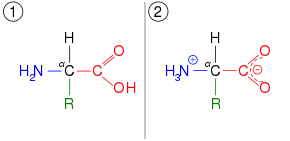Tautomers (/ˈtɔːtəmər/)[1] are structural isomers (constitutional isomers) of chemical compounds that readily interconvert.[2][3][4][5] The chemical reaction interconverting the two is called tautomerization. This conversion commonly results from the relocation of a hydrogen atom within the compound. The phenomenon of tautomerization is called tautomerism, also called desmotropism. Tautomerism is for example relevant to the behavior of amino acids and nucleic acids, two of the fundamental building blocks of life.

Care should be taken not to confuse tautomers with depictions of "contributing structures" in chemical resonance. Tautomers are distinct chemical species that can be distinguished by their differing atomic connectivities, molecular geometries, and physicochemical and spectroscopic properties,[6] whereas resonance forms are merely alternative Lewis structure (valence bond theory) depictions of a single chemical species, whose true structure is a quantum superposition, essentially the "average" of the idealized, hypothetical geometries implied by these resonance forms.
Tautomerization is pervasive in organic chemistry.[2][7] It is typically associated with polar molecules and ions containing functional groups that are at least weakly acidic. Most common tautomers exist in pairs, which means that the hydrogen is located at one of two positions, and even more specifically the most common form involves a hydrogen changing places with a double bond: H−X−Y=Z ⇌ X=Y−Z−H. Common tautomeric pairs include:[3][4]
Prototropy is the most common form of tautomerism and refers to the relocation of a hydrogen atom.[7] Prototropic tautomerism may be considered a subset of acid-base behavior. Prototropic tautomers are sets of isomeric protonation states with the same empirical formula and total charge. Tautomerizations are catalyzed by:[4]
Two specific further subcategories of tautomerizations:
Valence tautomerism is a type of tautomerism in which single and/or double bonds are rapidly formed and ruptured, without migration of atoms or groups.[9] It is distinct from prototropic tautomerism, and involves processes with rapid reorganisation of bonding electrons.
A pair of valence tautomers with formula C6H6O are benzene oxide and oxepin.[9][10]
Other examples of this type of tautomerism can be found in bullvalene, and in open and closed forms of certain heterocycles, such as organic azides and tetrazoles,[11]ormesoionic münchnone and acylamino ketene.
Valence tautomerism requires a change in molecular geometry and should not be confused with canonical resonance structures or mesomers.
In inorganic extended solids, valence tautomerism can manifest itself in the change of oxidation states its spatial distribution upon the change of macroscopic thermodynamic conditions. Such effects have been called charge ordering or valence mixing to describe the behavior in inorganic oxides.[12]
The existence of multiple possible tautomers for individual chemical substances can lead to confusion. For example, samples of 2-pyridone and 2-hydroxypyridine do not exist as separate isolatable materials: the two tautomeric forms are interconvertible and the proportion of each depends on factors such as temperature, solvent, and additional substituents attached to the main ring.[8][13]
Historically, each form of the substance was entered into databases such as those maintained by the Chemical Abstracts Service and given separate CAS Registry Numbers.[14] 2-Pyridone was assigned [142-08-5][15] and 2-hydroxypyridine [109-10-4].[16] The latter is now a "replaced" registry number so that look-up by either identifier reaches the same entry. The facility to automatically recognise such potential tautomerism and ensure that all tautomers are indexed together has been greatly facilitated by the creation of the International Chemical Identifier (InChI) and associated software.[17][18][19] Thus the standard InChI for either tautomer is
InChI=1S/C5H5NO/c7-5-3-1-2-4-6-5/h1-4H,(H,6,7).[20]
{{cite journal}}: CS1 maint: multiple names: authors list (link)